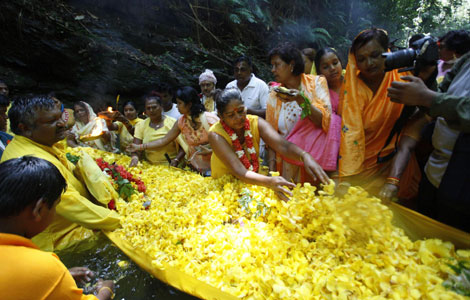Simply timeless in Hoi An
Updated: 2013-06-10 02:47
By Nguyen Thi Thuy Anh and Zhang Jianhua (China Daily)
|
||||||||
|
 |
|
A Chinese assembly hall in Hoi An. Such assembly halls were built by Chinese expatriates as a place to socialize and hold meetings. Zhang Jianhua / Xinhua |
Hoi An's ancient charms continue to wow visitors, Nguyen Thi Thuy Anh and Zhang Jianhua report.
Over the past few years, the ancient town of Hoi An, located some 650 km south of Hanoi, has become a favorite tourist destination in Vietnam.
Hoi An, which used to be an international trading port in central Vietnam's Quang Nam province, has exceptionally well-preserved architectural wonders that include old houses, temples, pagodas, and other structures built from the 15th to the 19th century. In 1999, the old town was recognized as a World Heritage site by the United Nations Educational, Scientific and Cultural Organization.
Mostly made of wood in the traditional styles of Vietnam and neighboring regions, the structures found in the town have withstood the test of time. The town is also famous for its made-to-order shoes and sandals.
"My shop sells a lot of shoes, and we can make various models of made-to-measure shoes that our customers, including foreign tourists, love to buy," a shop owner in Hoi An said.
The shop owner, who has been in the business for 10 years, said that his customers include tourists from Britain, France, Australia and the United States.
Making shoes is only one of the various industries in Hoi An, which is now considered a paradise for shoppers because of its high-quality locally made products that are sold at low prices.
According to old-timers here, Chinese and Japanese traders and craftsmen flocked to Hoi An during the 18th century, and some of them settled permanently in the town.
Among the structures in Hoi An that bear Chinese and Japanese influences are the Chinese temples and assembly halls as well as a Japanese covered bridge known as Japanese Bridge.
The assembly halls are places where Chinese expatriates used to socialize and hold meetings. There are five assembly halls in Hoi An built by different groups of Chinese immigrants — Fujian, Qiongfu, Chaozhou, Guang Zhao, and the Chinese Assembly Hall.
Most of the assembly halls in Hoi An have the same layout, including a grand gate, a beautiful garden, a main hall and a large altar room. However, because each Chinese community has its own beliefs, different assembly halls worship different gods and goddesses.

 Michelle lays roses at site along Berlin Wall
Michelle lays roses at site along Berlin Wall
 Historic space lecture in Tiangong-1 commences
Historic space lecture in Tiangong-1 commences
 'Sopranos' Star James Gandolfini dead at 51
'Sopranos' Star James Gandolfini dead at 51
 UN: Number of refugees hits 18-year high
UN: Number of refugees hits 18-year high
 Slide: Jet exercises from aircraft carrier
Slide: Jet exercises from aircraft carrier
 Talks establish fishery hotline
Talks establish fishery hotline
 Foreign buyers eye Chinese drones
Foreign buyers eye Chinese drones
 UN chief hails China's peacekeepers
UN chief hails China's peacekeepers
Most Viewed
Editor's Picks

|

|

|

|

|

|
Today's Top News
Shenzhou X astronaut gives lecture today
US told to reassess duties on Chinese paper
Chinese seek greater share of satellite market
Russia rejects Obama's nuke cut proposal
US immigration bill sees Senate breakthrough
Brazilian cities revoke fare hikes
Moody's warns on China's local govt debt
Air quality in major cities drops in May
US Weekly

|

|








